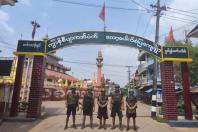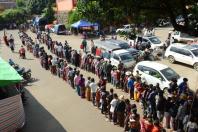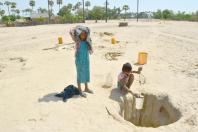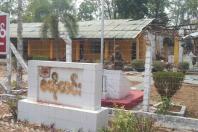
In Myanmar’s history, King Narathihapate, also known as the “Taruk-Pyay Min” (meaning “the King who fled from the Taruks”), ruled from 1254 to 1287. During his reign, the First Myanmar Kingdom met its demise.
In 1271, following the Mongol King Kublai Khan’s conquest of China, the governor of Yunnan dispatched an ambassador to Myanmar, requesting the continuation of gifts from Rakhine (Arakan). However, King Narathihapate declined to receive the Chinese ambassadors. Subsequently, in 1273, the Chinese central government, under Kublai Khan, sent another diplomatic mission to Myanmar, reiterating their demands. Narathihapate responded by executing the members of this mission.
In 1273, the Duke of Kannge from Bhamo entered China and pledged allegiance. The Myanmar people attempted to attack the Duke. Seeking assistance, the Duke requested help from the Chinese, leading to the Governor of Yunnan invading and attacking Myanmar. Consequently, the Sino-Myanmar war erupted. In 1277, Chinese and Burmese forces clashed in Ngesongchan, situated in the Tapin River basin above the city of Kanyan. Unfortunately, the Myanmar army suffered defeat, prompting the Chinese troops to advance toward Bhamo. However, due to the intense heat, they eventually withdrew from Myanmar.
In 1283, following another Myanmar attack on the Yunnan border, the Chinese launched their second invasion of Myanmar. Their assaults took place in Kaungsin, near Bhamo. Unfortunately, the Myanmar army suffered defeat, and the Chinese established their presence along the Ayeyawady River basin. Despite King Narathihapate’s intentions to resist the Chinese, his efforts proved unsuccessful, earning him the epithet “Taruk-Pyay Min.”
Following this, Narathihapate dispatched an ambassador, and as a result of negotiations, the Chinese troops under the Mongol King Ku Balai Khan withdrew from Myanmar. During Narathihapate’s journey from Pathein to Bagan, he received news that his son Thiha Thu would assassinate him in Pyay. He was invited to partake in a poisonous feast, which ultimately led to his demise.
Following King Narathihapate’s passing, several subordinate states—including Rakhine State, Shan State, Hanthawady, and Mon regions like Mottama, Linzin, and Zinme—revolted, leading to the fall of Bagan in 1287. Interestingly, during this period, the Chinese were absent from Myanmar. Despite the favorable circumstances for rebuilding the country, the lack of unity ultimately contributed to its destruction.
Amidst the turmoil and statelessness following the destruction of Bagan city, Yetisuma—the grandson of Kublai Khan from Yunnan—returned to Myanmar. His actions led to the collapse of the First Kingdom of Myanmar.
As Myanmar faced disintegration and regressed toward the status of a city-state, the establishment of the Second Myanmar Kingdom began under the reign of Tabinshwehti in the Toungoo Dynasty. Subsequently, during the rule of King Bayintnaung (who ascended the throne in 1550), Myanmar experienced a period of strength and power. Unfortunately, this era came to an end with the king’s demise in 1581. The Second Myanmar Kingdom faced further disintegration in 1599 due to defeats by Yodya, rebellions by subordinate dukes, and attacks from the Arakan King.
Alaung Mintayagyi U Aung Zeya, during the Konbaung period, founded the Third Myanmar Kingdom in 1752. Under the reign of this dynasty, King Sagaing (Ba Gyidaw), the First Anglo-Myanmar War erupted between 1824 and 1826. Unfortunately, during this conflict, Myanmar lost control over Assam, Manipur, Rakhine, and Taninthayi.
In 1852-1853, during the reign of King Bagan, the Second Anglo-Myanmar War erupted, resulting in Myanmar’s defeat. As a consequence, Lower Myanmar had to be surrendered. Later, in 1885, the third Anglo-Myanmar war occurred during the reign of King Thipaw. Tragically, Myanmar lost this war as well, leading to the entire country falling under British control.
Under British rule, Myanmar experienced a divide-and-rule policy. However, after gaining independence on January 4, 1948, the country faced armed conflict and civil war, which persist to this day.
Amidst internal conflicts, further armed confrontations have erupted following the political changes in 2021. On October 27, 2023, the Northern Alliance armed groups launched an offensive known as “Operation 1027,” deploying substantial manpower and weaponry. Speculation arose regarding China’s potential involvement behind the scenes in these attacks. Alongside the alleged Chinese role in the conflict in northern Shan State, there have been critical assessments of the current situation, drawing parallels to historical incidents during the reign of King Narathihapate. Notably, protests have also emerged against China’s stance.
Conversely, China has categorically denied providing any support to the Northern Alliance. The Chinese authorities have actively encouraged all parties involved to engage in dialogue and swiftly establish a ceasefire in the ongoing conflict in northern Shan State. In pursuit of this goal, China facilitated a meeting between the State Administration Council (SAC) and the Northern Alliance in Kunming, Yunnan Province. As of now, there appears to be a tentative ceasefire between the Myanmar military and the Northern Alliance.
■ Are Operation 1027 and fighting in Rakhine State a proxy war?
Currently, powerful countries around the world engage in military and economic competition not within their own borders, but rather in other countries. These conflicts are often labeled as proxy wars.
In the development of proxy wars, major nations carefully assess the advantages they stand to gain from a particular country. This consideration applies to both past and ongoing proxy conflicts.
Notable instances include the ongoing conflict between Israel and Hamas, the Ukraine-Russia war, and the wars in Libya and the Middle East (such as Syria). In these cases, large countries participate due to the substantial benefits they derive, including access to oil and energy resources.
In northern Shan State, three allied armed groups—the Kokang Armed Forces (Myanmar National Democratic Alliance Army, or MNDAA), the Ta’ang National Liberation Army (TNLA), and the Arakan Army (AA)—have engaged in conflict. The impetus for this fighting, led by the Rakhine Armed Group (AA) and other factions, was the launch of Operation 1027 on October 27. The operation aimed to address multiple issues, including combating the military dictatorship, tackling online gambling fraud, and addressing online fraud within Myanmar, particularly along the China-Myanmar border.
While the primary objective of Operation 1027 was multifaceted, the MNDAA group, a key actor in the operation, had a specific motive: to secure the possibility of resettlement in the Kokang region.
During the operation, the MNDAA group collaborated with its allies. Interestingly, the powerful Wa armed group also became indirectly entangled in the conflict. Analysts note that the Wa group, which operates its own military and administrative systems, is often regarded with envy by various ethnic armed groups. Within the northern alliance armed groups, the Wa group occupies a prominent leadership position.
The Wa group exercises control over its region through a centralized system, devoid of elections.
Given this context, the 1027 operation conducted by other ethnic armed groups, including their ally MNDAA, cannot be unequivocally linked to the struggle for democratic revolution. Instead, there are indications that these actions primarily serve the interests of each individual group.
The Federal Political Negotiation and Consultative Committee (FPNCC) FPNCC, led by the United Wa State Party (UWSP), comprises seven ethnic armed groups. Notably, the FPNCC has not yet signed the Nationwide Ceasefire Agreement (NCA). The member organizations include: UWSP, Kachin Independence Organization (KIO), Shan East Special Region (4) Peace and Unity Committee (PSC), Shan State Progressive Party (SSPP), Myanmar National Truth and Justice Party (MNTJP), United League of Arakan (ULA) and Palaung State Liberation Front (PSLF).
According to the constitution, Article 56 defines self-administered zones and regions.
Based on the 2014 population census, the Palaung Self-Administered Zone, where the TNLA is active, has a population of just over 100,000 (110,805).
Similarly, the Kokang Self-Administered Zone, where the MNDAA operates, also has a population of just over 100,000 (123,733) according to the same census.
The Wa Self-Administered Zone, in which the UWSA operates, boasts a population of over 450,000 (462,915).
Moving on to the Special Region (4), where the NDAA operates, the population stands at just over 100,000 (116,887).
In contrast, the Special Region (3), where the SSPP is active, is home to only over one million people (1,039,693).
Kachin State, where the KIA operates, has a population of just over a million and a half (1,689,441).
Finally, Rakhine State, where the AA operates, has a population of just over three million (3,188,807).
Considering the population of the regions inhabited by ethnic armed groups that are members of the FPNCC, the total number exceeds six million (6,732,281) according to the 2014 census.
Given that Myanmar’s overall population stands at over 56 million, the population of these armed groups in those regions constitutes just over 10 percent of the country’s total population. Consequently, some argue that the struggles of these armed groups solely represent their people and their respective regions, making it seemingly impossible for democratic change across the entire country.
They themselves rule their regions with armed forces, and they have never even heard the word of elections in their regions, nor have they been allowed to do so. Therefore, the fighting in these areas is not likely to change the emergence of a democratic federal union on a national scale, and there are already reviews that drug problems in these areas are likely to become serious due to ethnic armed groups.
Currently, there is a temporary ceasefire between the Tatmadaw and the three northern armed groups in northern Shan State, but the fighting between the Tatmadaw and the AA continues in Rakhine State.
If we look back at the history of armed groups operating in the China-Myanmar border region, we will see that China's influence may be more or less present.
"These ethnic armed groups cannot stay in the border region without the help of other country. It is the same situation along the Thai border and Chinese border. They went there and come back. They seek help from there. That's what they're doing. So how we see China is ever since the war with Burma's Communist Party (BCP) and the Tatmadaw, China's support has been apparent. Even after the collapse of the BCP, the central groups were given a sense of fostering and support. Dr. Hla Kyaw Zaw is getting its support now. It's the same situation now. It’s like carry fire in one hand, and water in the other. So, how they will respond to our good behavior? We will have to watch how they react and deal with the SAC," said U Kyaw Zeya, a former member of parliament.
After the start of the Operation 1027, the statements of the Northern Alliance stated that they captured 18 towns in northern Shan, Rakhine and Chin states. The capture of 18 towns by the three northern allies in a period of more than three months is arguably the largest since the previous rebels’ attacks.
Ethnic armed affairs analysts said that the three northern allies had to use thousands of tons of weapons in addition to manpower in order to carry out the town capture battles.
Among the ethnic armed groups on the China-Myanmar border, there are reports that there are weapons factories in "Wa" and KIA areas, and military analysts have also commented that these factories will not be able to be produced unless China provides technical support.
The fighting that took place in North Shan State was a well-planned mission by the opposing armed groups to take over the city based by the online fraud gangs, using a large number of manpower and weapons. There are reviews that it was carried out with a kind of territorial invasion war under the pretext of authoritarian revolution.
In addition, some observers of Myanmar affairs are commenting that the fighting that took place in northern Shan State is similar to Russia's occupation of Crimea on the border of Ukraine from February 20 to March 21, 2014.
■ Financial and military expenditure of ethnic armed groups
Northern armed groups are based on the China-Myanmar border and are widely seen as proxies of China.
After the political conflict in 2021, even many armed groups opposed to the SAC did not have the money to buy their weapons, and many campaigns for financial donations were active on social networking sites. Northern armed groups have been questioned the widespread use of military equipment.
At present, only the members of the Federal Political Negotiation and Consultative Committee (FPNCC), led by the "Wa" group, were able to carry out the city-occupation battles on a large scale. The NUG, which emerged after 2021, supported and armed the PDF, but did not appear to have grown into a powerful opposition force. Currently, there is only one town, Kawlin, which can be taken over by NUG-affiliated PDFs.
On November 6, 2023, the NUG announced that it had attacked and captured Kawlin, a district-level town in Sagaing Region.
After the capture of Kawlin, the NUG-affiliated PDFs could not continue to capture any town.
In that situation, the SAC announced that the Tatmadaw was able to recapture Kawlin on February 10.
The NUG-affiliated PDFs are not yet in a situation where they can compete with the Tatmadaw because there is no powerful country to support them and they are fighting only through donations from the public.
However, during the Operation 1027, the three northern allies were questioned about the manpower and military support they received behind the scenes as they fought to capture the town.
According to some observers of northern Shan affairs, the strength of the northern armed groups in the Northern Shan battle is about 30,000.
In addition, in the attack on military security bases in northern Shan State, there are about 6,500 people including Kokang from the other forces which are gathered and foreign drone experts in addition to the TNLA, KIA and AA, and the attack was carried out with about 25,000 drop bombs and about 120 107-mm homemade rockets, said State Administration Council’s Chairman Senior General Min Aung Hlaing at the meeting of the State Administration Council held on November 29, 2023.
In any case, it will be necessary to monitor how the armed groups, which will grow more and more through these battles, will be able to obtain the financial expenses and military expenses that will be needed in the future.
It is considered that most of the ethnic armed groups in Myanmar will get their military expenses and finances mainly from opium and drugs, no matter how much they deny it.
"When ethnic armed groups emerged along the China-Myanmar border, their main business was drug production. They used to grow poppy. The Golden Triangle area used to be the second largest drug producer in the world. Now some are saying that it is even the first place. Mainly, neither country can fully control this border region. Successive governments have taken measures to combat drugs, but there are some aspects that have not been fully implemented. Another thing is that the ethnic armed organizations living in this region are dependent on the production of this drug to survive, to buy their weapons and ammunition and to support their members. In short, all ethnic armed groups are dependent on the production of these drugs. As modern systems improve in the production of major drugs, technologies are also advanced. The chemicals used in the production of drugs are not the chemicals produced here. It's coming from neighboring countries," said Dr. Naing Swe Oo, founder and executive director of the ThayNinGa Institute for Strategic Studies.
Currently, in December 2023, more than two tons of ICE (methamphetamine) worth 51.87 billion kyats and 800 kilos of the controlled chemical caffeine were seized and a drug smuggling gang was arrested in Shan State and Yangon Region, announced the SAC.
SAC released a list of names of those arrested in the drug smuggling gang, including members of the Arakan Army (AA).
The AA did not deny that they did not know the members involved in the drug seizure or they were not members, but responded by saying that the SAC was spreading propaganda by accusing them of drugs and other discrediting allegations.
In terms of opium and drugs, opium is mainly grown in Shan State and Kachin State of Myanmar, with some cultivation in other regions as well. Mind-altering drugs, which are chemically brewed drugs, come from Shan State and are shipped to other parts of Myanmar as well as other foreign countries.
There are three main routes used by drug producers and distributors from Myanmar to export drugs to countries around the world: the route through Bangladesh bordering Rakhine State, the sea route to Malaysia, where there are many Rakhine people and the route through Thailand, which borders the UWSA and has strong border armed groups.
It is estimated that the strength of ethnic armed groups in Myanmar may be between 500,000 and 600,000. The permanent strength of the Tatmdaw is estimated to be between 200,000 and 300,000.
It is difficult to know exactly, but according to the analysis of the experts, there are estimates that the military spends about three billion kyats a year, while the opposition armed groups spends about one billion kyats a year.
If we look at the history of the operations of most ethnic armed groups in Myanmar, we will see that they are not free from the money that flows from opium and drugs, and that there are groups that have grown in power with this money.
Currently, the "Wa" armed group, which can be said to be the most powerful ethnic armed group in Myanmar, has a notorious reputation for poppy cultivation and drugs. The "Wa” doesn’t allow any group to investigate it in their controlled area to clear up the accusations of opium and drugs.
To be continued.










